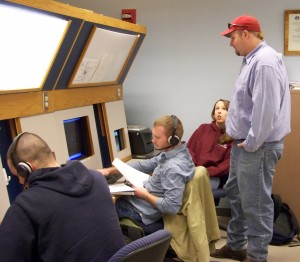
Instructor Andy Farr (left) and a student review feedback from the air traffic control voice recognition software.
By Ray Cober
Air traffic controllers are in high demand, and with controllers retiring in droves every year, the need for highly skilled and educated replacements has never been greater. To create a supply, in 2006 the Federal Aviation Administration increased the number of schools qualified for air traffic instruction under the Air Traffic Collegiate Training Initiative. Metropolitan State College of Denver recently joined the program.
“The FAA announced that it was accepting applications from four colleges to become a part of the ATC-CTI program,” explained Prof. James Simmons, one of the program’s instructors.
Metro State applied and received notification in October that it had been selected as one of nine schools added to the program.
In 1990, the FAA designated 14 colleges around the country as AT-CTI schools. Prior to the program, most controllers were military retirees who’d gained experience with the Air Force or Navy, but some were “off-the-street” hires, hired and trained by the FAA. This training was often the first exposure applicants had to aviation.
“Now, the FAA has found that students who go through a collegiate training program have a much higher success rate in training,” Simmons explained.
As waves of current controllers enter retirement, the FAA placed greater emphasis on the AT-CTI program and qualified additional schools, now totaling 23.
“The ATC system went through a huge change in 1981, when Ronald Reagan fired about 11,000 controllers,” said Simmons. “Those who were hired after the 1981 strike are now reaching mandatory retirement age. So, the FAA needs several thousand people to be hired in the next few years.”
Metro’s ATC program curriculum consists of 40 class hours. Once students complete the curriculum, they’ll be given a final knowledge exam designed around specific knowledge determined by the FAA. The exam includes questions regarding chart interpretation, approach procedures, flight rules and weather knowledge. To be recommended for FAA hire, students need a final score of at least 70 percent, along with at least a 3.0 grade point average.
The recommendation, however, is just that.
“It’s not a guarantee, even passing the college program, passing the final exam and passing with a B average, to even get an interview with the FAA, much less get hired,” Simmons said.
The FAA has its own Air Traffic Standard Aptitude Test. Applicants must score at least 70 percent on the ATSAT, which consists of logic tests, as well as computerized simulations designed to measure an applicant’s ability to handle multiple concurrent tasks. Students must also pass background checks and medical exams and continue with an additional two to three years of training.
The FAA’s maximum ATC hiring age is 31, with exceptions made for previously trained military controllers.
“The FAA says that according to its experience, younger people do better,” says Simmons.
And once controllers are hired, they must contend with a relatively early retirement age: 56.
“Some can stay to up to 61, but it’s seldom done,” Simmons said.
Simmons adds that this rare extension is granted only to those showing “exceptional skills and experience” and only for work at short-staffed ATC facilities.
“That’s the federal statute, but maybe it will change someday,” Simmons said. “In some people’s minds, that’s too young to retire.”
Metro’s ATC curriculum involves lectures and “book learning,” but its program centerpiece is the “World Indoor Airport,” a complete virtual training facility for both pilots and controllers. Occupying a large room, the floor’s crowded with flight simulators for advanced instrument instruction and large detailed maps for navigation. An entire wall is lined with digitized ATC simulators capable of authentically replicating a real airport environment.
Raytheon developed the ATC equipment software, which emulates the type of varying air traffic associated with local airports, from Centennial, Front Range and Rocky Mountain Metropolitan, to Denver International’s constant mixed influx of business jets, regional turboprops and heavy wide bodies. Raytheon’s voice recognition and audio feedback software nearly eliminates the differences between simulation and the real thing.
But a few bugs remain stubbornly nested in the software. Andy Farr, an adjunct professor with the program, and his assistant, Logan Rogers, voiced their frustration when the software had difficulty picking up or recognizing verbal commands. Early on, students had to be trained to speak in an almost monotone, paced manner that many complained was unrealistic. Raytheon has worked to address this issue.
Student Marcus Doyle has experienced this obstacle but had high praise for everything else. He first became interested in air traffic control though Microsoft’s series of home flight simulation software.
“The class is very informative,” Doyle said. “I had a good ATC base beforehand, but now I’m refreshing and relearning.”
He says the realism gives a clear picture of the true volume of aircraft and traffic involved.
“We’re learning the flow of aircraft and trying to stay ten steps ahead of every pilot on the screen,” he said.
Doyle adds that the program is valuable for students in the professional pilot program.
“They’re learning about the other side—putting themselves in the controllers’ shoes,” he said. “They’re even thinking about how this knowledge will help them with the ATC portion of the FAA written flight exam.”
Fellow student Chelsea Fry echoes Doyle’s sentiment. As a student of the professional pilot program, she chose the class as an elective.
“It helps us learn as pilots, working in the lab with hands-on experience,” she said. “Probably the hardest for most is to get the lingo down, learning about the different airspace types and flight levels.”
Rogers thinks the students underestimate their true grasp of skills and is optimistic about their future.
“I’m hoping the program will open up a wide variety of career options,” he said.
For more information about Metropolitan State College of Denver’s Air Traffic Collegiate Training Initiative program, call 303-556-2983 or visit [http://www.mscd.edu/~aviation].












